Stonecrop (sedum) is a close relative of the money tree. It is part of the large family Crassulaceae. The Sedum genus unites more than 500 varieties that are shrubs, herbaceous plants, or succulents. Among the species, one and biennials, as well as perennial flowers, are found. In nature, stonecrop grows in the temperate climate of North America, Asia, and Europe.
In floriculture, sedum-succulents are mainly grown. Most sedums can be planted as ampelous flowers, because in the wild they grow on stones and rocks, gracefully hanging from them. Stonecrop is a fairly common plant that does not require special care, but it is very easy for a beginner grower to get confused in numerous types and varieties of plants, so it is worthwhile to study their description and photo in detail, which will help you make a choice.
Content
- 1 Plant Description and Growing History
- 2 Ground cover (creeping) types and varieties of stonecrop with photo
- 2.1 Anacampseros (Sedum anacampseros)
- 2.2 White (sedum album)
- 2.3 Pale yellow (Sedum ochroleucum)
- 2.4 Cornflower blue (Sedum cyaneum)
- 2.5 Leafy (Sedum dasyphyllum)
- 2.6 Caustic (sedum acre)
- 2.7 Siebold (Sedum sieboldii)
- 2.8 Kamchatka (Sedum kamtschatikum)
- 2.9 Blushing (Sedum rubrotinctum)
- 2.10 False (Sedum spurium)
- 2.11 Scapular (Sedum spathulifolium, Sedum pruniosum)
- 2.12 Morgana (Sedum morganianum)
- 2.13 Divergent (Sedum divergens)
- 2.14 Forster (Sedum forsterianum)
- 2.15 Eversa (Sedum ewersii)
- 3 Shrub (tall) types and varieties of stonecrop with photo
- 4 Home cleaning at home
- 5 Common questions
Plant Description and Growing History
Stonecrop has always attracted others with its interesting appearance. Its matte leaves are very juicy and creaky, which became the reason for the common names - hare cabbage and creaks. In olden times, the most common was sedum with red flowers. Naturalists Pliny and Dioscorides described Sedum as a medicine for healing wounds, for diseases of the skin and even for bone fractures. Traditional medicine today uses plant-based drugs to heal wounds of a diverse nature, including severe burns.
Most gardeners prefer to grow stonecrop as an ampel plant, because its shoots spread beautifully on the ground. The length of the flower can reach 2 m. The leafless foliage has a rounded, slightly oblong shape with pointed edges and resembles water droplets. Known species with spherical and flat leaves. Flowering occurs in May and lasts through October. The flowers are lilac, yellow, lilac, white or pink.
In gardening cultivate species that are resistant to cold. There are many more varieties of stonecrop, so everyone can choose the most suitable sedum for themselves.
Ground cover (creeping) types and varieties of stonecrop with photo
Ground cover species are great for designing a site in any style. They are planted together with perennials, grassy flowers and compact shrubs that have similar requirements for growing conditions. You can plant sedums in small flowerpots, and also give them a whole lawn, the only minus of which will be completely covered land on which you can’t walk.
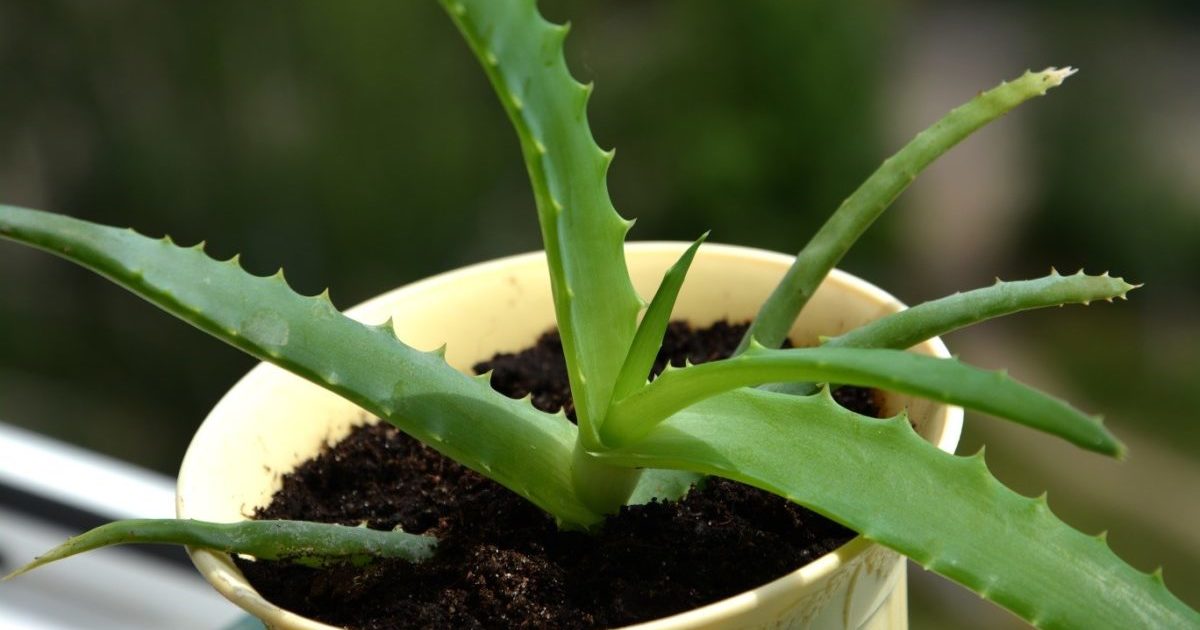 You may be interested in:
You may be interested in:Anacampseros (Sedum anacampseros)
Creeping shoots take root easily. The flower has leaves with blue tint and pink inflorescences. The color of the petals at the end of flowering changes to purple.
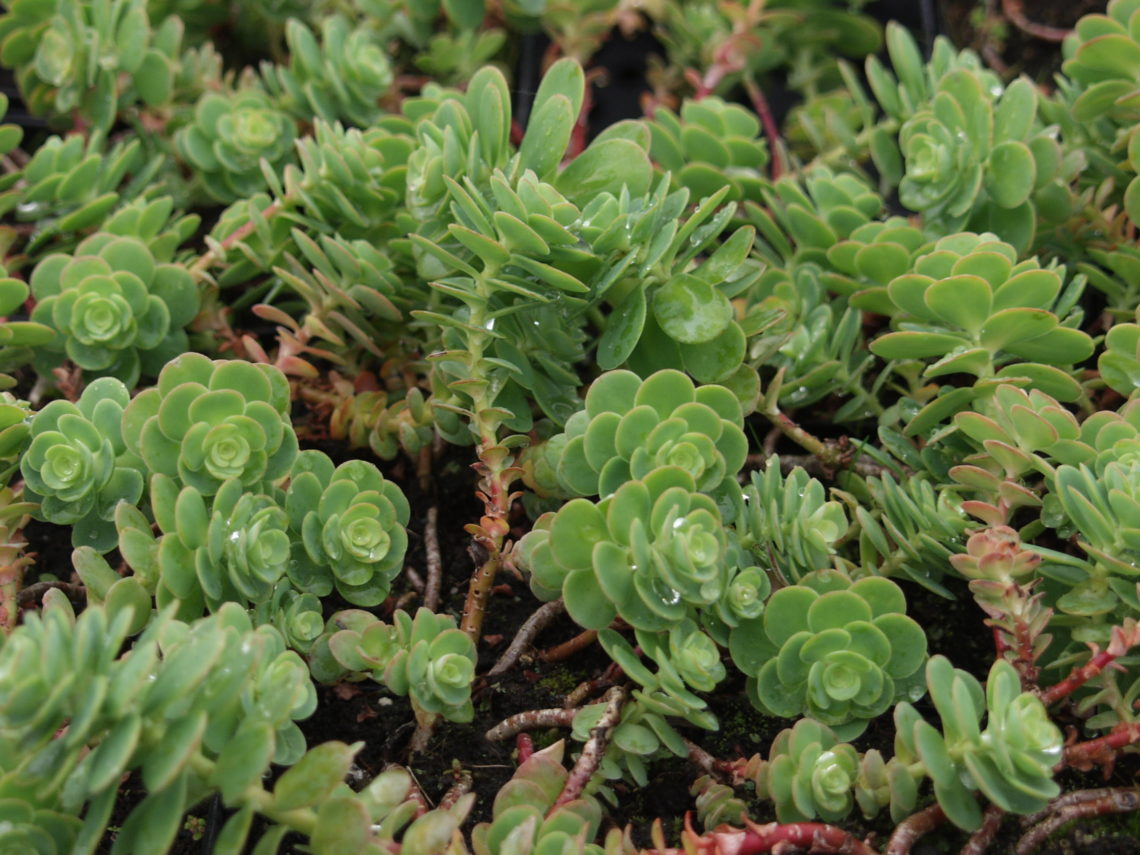
The height of one peduncle varies between 15-20 cm, and the diameter of the compact flower is 0.7 cm. The flowering period lasts from July to August.
White (sedum album)
The evergreen plant is small in size. The height of the creeping stems does not exceed 7 cm. The fleshy leaves of a linearly oval shape reach a length of 1 cm. During the period of active growth, the foliage is colored green, and by the beginning of autumn it becomes reddish.
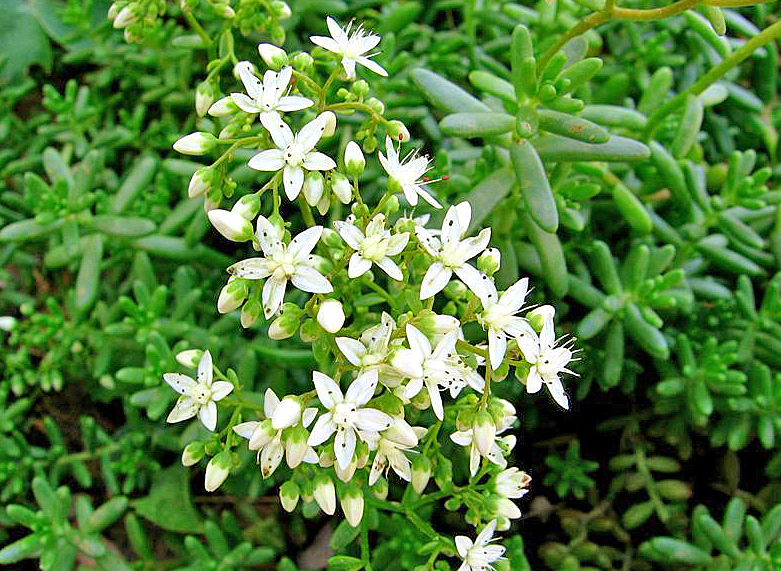
Small white flowers have a pleasant aroma. They are collected in umbrella-shaped inflorescences, which can reach 10 cm. The variety blooms in early or mid-summer.
Pale yellow (Sedum ochroleucum)
The greenish-white or creamy inflorescences of sedum have glandular pubescence on the sepals. The species is growing quite slowly. The color of foliage is bluish or brownish.
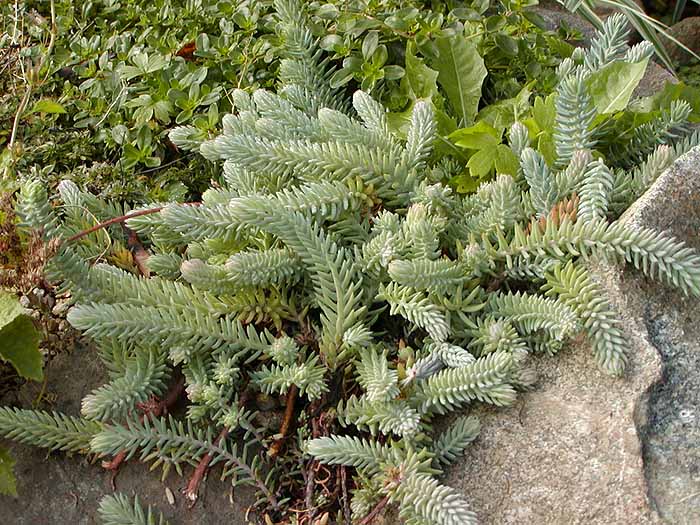
Bluish species are grown most often. They are planted in sunny areas or slides. The pale yellow stonecrop is characterized by excellent resistance to frost.
Cornflower blue (Sedum cyaneum)
Cornflower blue sedum forms stems up to 10 cm high. The deciduous part is bluish-blue in color, its surface is covered with dots of reddish color.
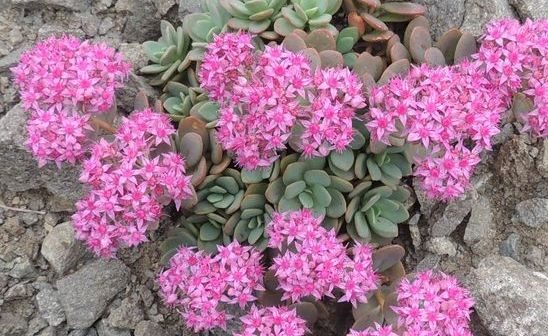
In August-September, the plant produces small pink-purple flowers. A distinctive feature of the species is good frost resistance. Rose Carpet and Rosenntepich varieties are popular.
Leafy (Sedum dasyphyllum)
The leafy stonecrop forms a wide dense cover of soil. Green leaves are densely located on creeping stems. In late summer, light yellow flowers bloom on peduncles up to 25 cm long.
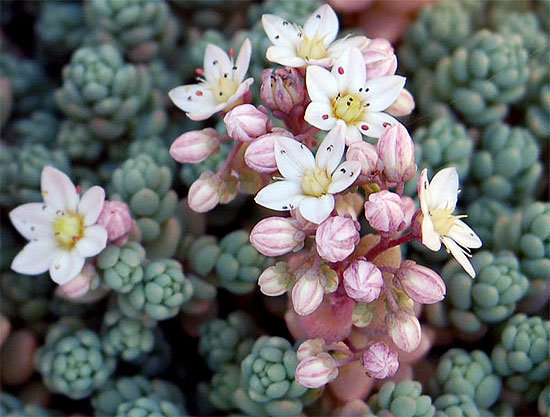
After flowering, brown fruits ripen on the plant, the decorativeness of which is often used to create floral arrangements. Common varieties: Lloyd Preger, Opelin, Lilac Mound.
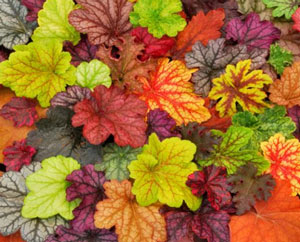 You may be interested in:
You may be interested in:Caustic (sedum acre)
This variety has a short root system with fairly thick roots. Plants up to a year are densely covered with leaves, and there is no flowering. In the second year of life, the number and size of the deciduous part are significantly reduced, and a lot of golden flowers form on upright peduncles. Depending on the growing climate, flowering continues throughout the summer.
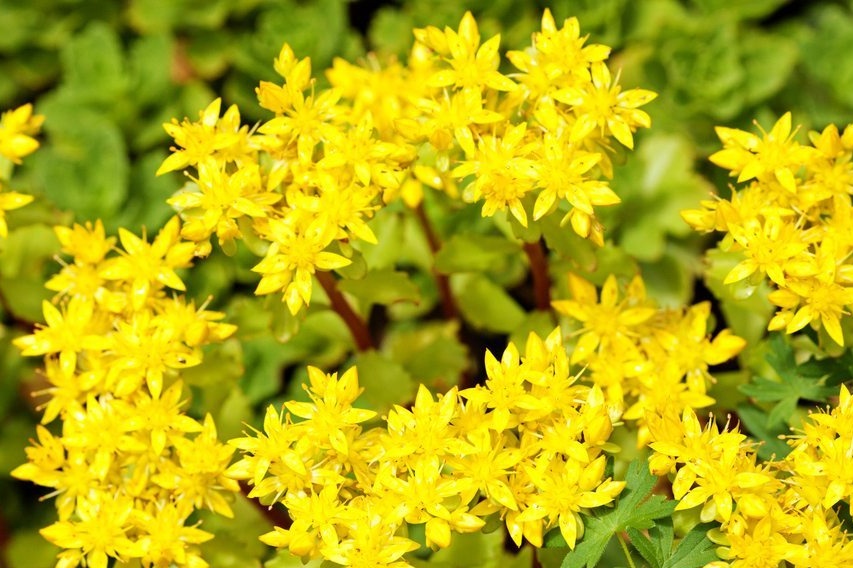
Siebold (Sedum sieboldii)
Siebold Sedum is distinguished by green leaves with a pink tint. Thin stems of reddish tones reach 10 cm. Foliage can be painted in blue-gray or green with a blue tint. Some varieties are cast in red along the edge of the sheet. Dense inflorescences have a purple or pink color. The most commonly grown varieties are Dragon and Medovariegatum.
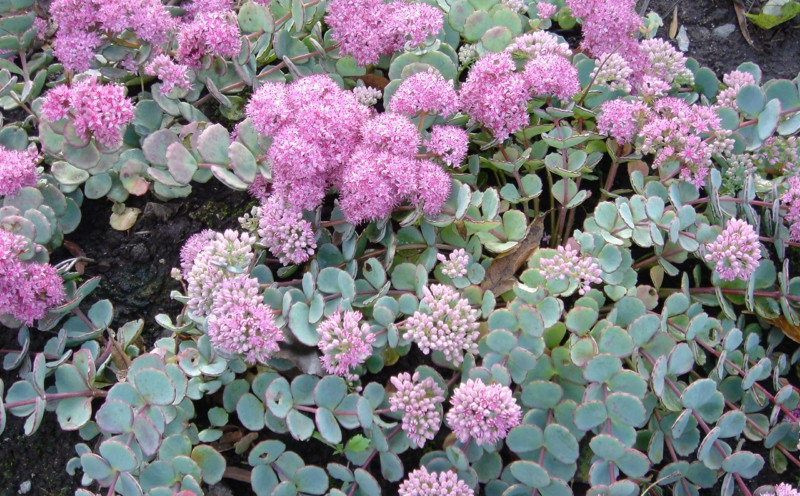
Kamchatka (Sedum kamtschatikum)
Herbaceous perennial differs in small sizes and strongly branching tree roots. Dense shoots most often do not exceed twenty centimeters. Hard toothed foliage is flat. The peak of flowering occurs in June. The plant forms many small yellow flowers that bloom for 30 days. Popular varieties are Texari Dyke and Variegatum.
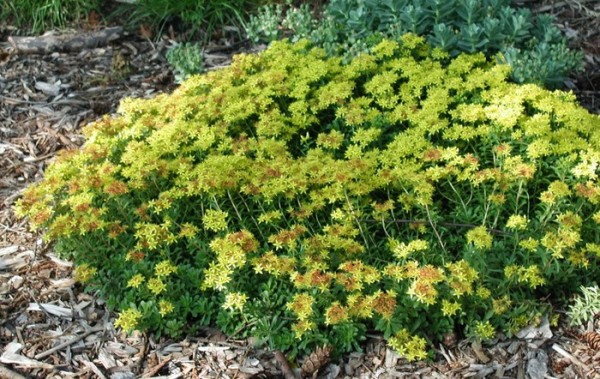
Blushing (Sedum rubrotinctum)
A short perennial has creeping stems, which eventually rise slightly above the soil. The rounded foliage is dark green. The tops of the leaves become reddish as they grow. The plant blooms with bright red flowers.
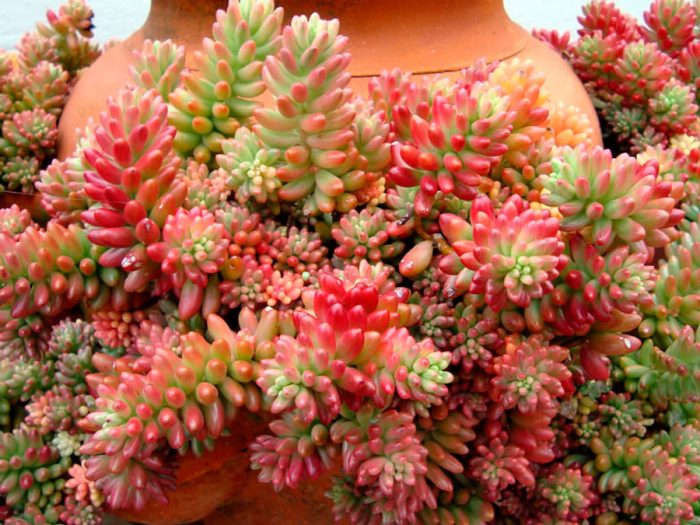
False (Sedum spurium)
Creeping and slightly raised shoots of stonecrop can reach 25 cm in length. Thickened foliage has an egg-shaped wedge-shaped shape. The color of the leafy part is dark green, and the leaf length is not more than 2 cm.The flowering phase lasts from July to August. Inflorescences with a diameter of 10 cm have a purple-pink hue. The most common varieties are Album, Elizabeth, Tricolor.
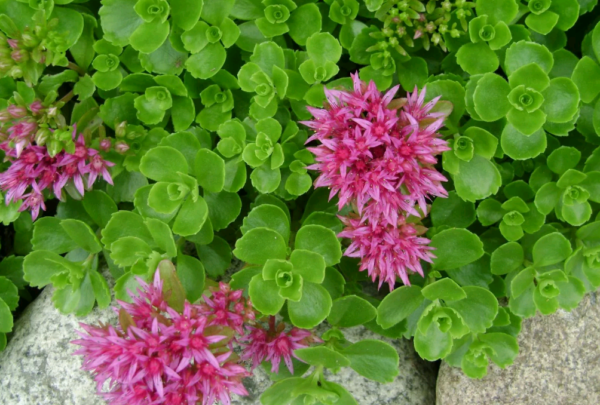
Scapular (Sedum spathulifolium, Sedum pruniosum)
The flower forms dense rugs about ten centimeters high. Green foliage has a silver coating with a bluish tint. When interacting with the sun, the leafy part often acquires a pink hue. Yellow flowers bloom in May and June. The most popular varieties are Harvest Moon and Aureum.
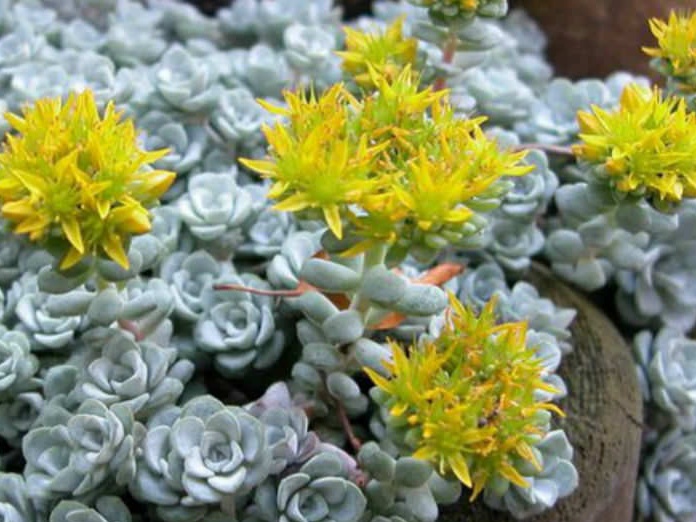
Morgana (Sedum morganianum)
The densely leafy stems of the flower can grow about 1 m in length. Fleshy leaf plates have a rounded, oblong shape with slightly pointed tips. Cystic or corymbose inflorescences are painted in red-pink shades. In indoor conditions, the flowering period begins at the end of winter.
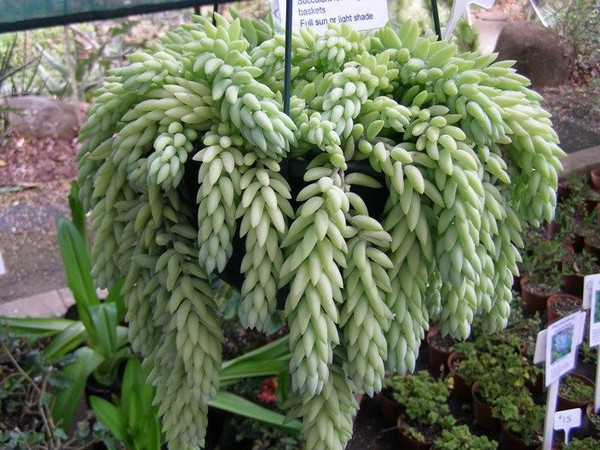
Divergent (Sedum divergens)
Low flower bushes have green foliage, which often gets red when in contact with the rays. Yellow flowers grow on pedicels, the size of which does not exceed 0.1 m. The plant is distinguished by its unpretentiousness to the composition of the soil.
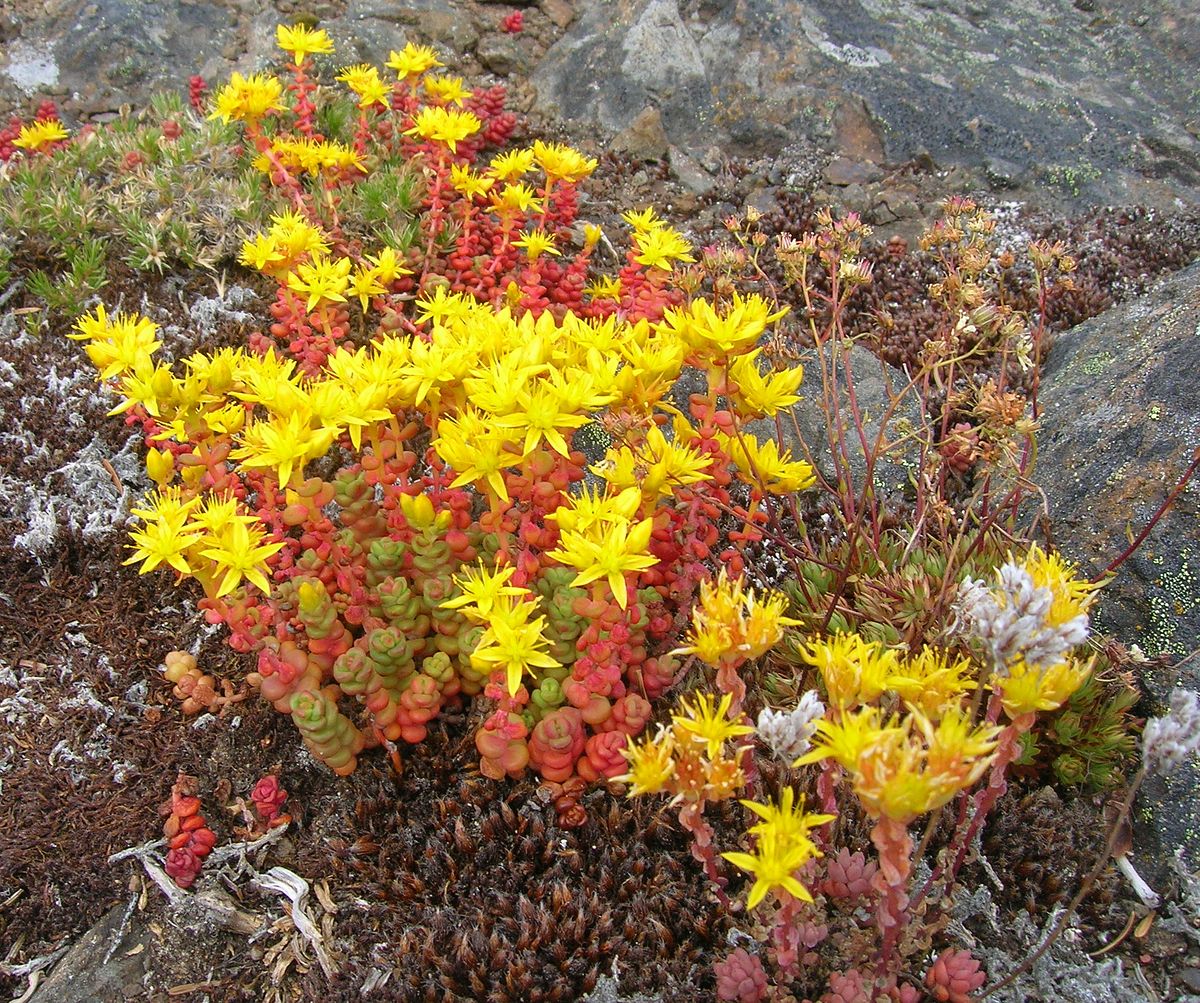
Forster (Sedum forsterianum)
Forster's sedum is fast growing. The height of leafy shoots does not exceed 0.1 m. Yellow flowers form on high pedicels. Foliage is green, bluish or purple. The flower is grown in the garden, and in flowerpots. Often cultivated varieties are Elegans, Purple, Oracle.
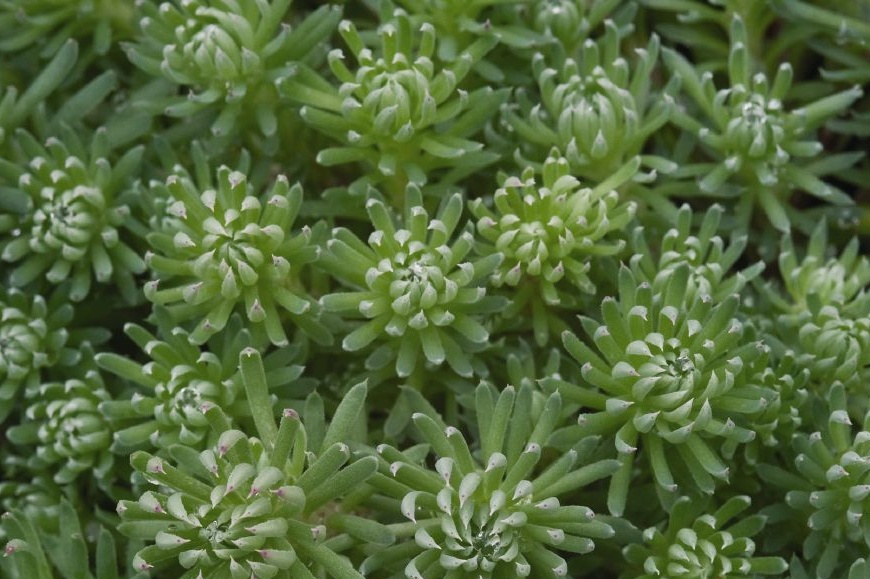
Eversa (Sedum ewersii)
The undersized perennial has lignified stems and roundish bluish leaves. The flowering period falls on July-August. Thyroid inflorescences are pink. This variety is well grown both in the garden and indoors.
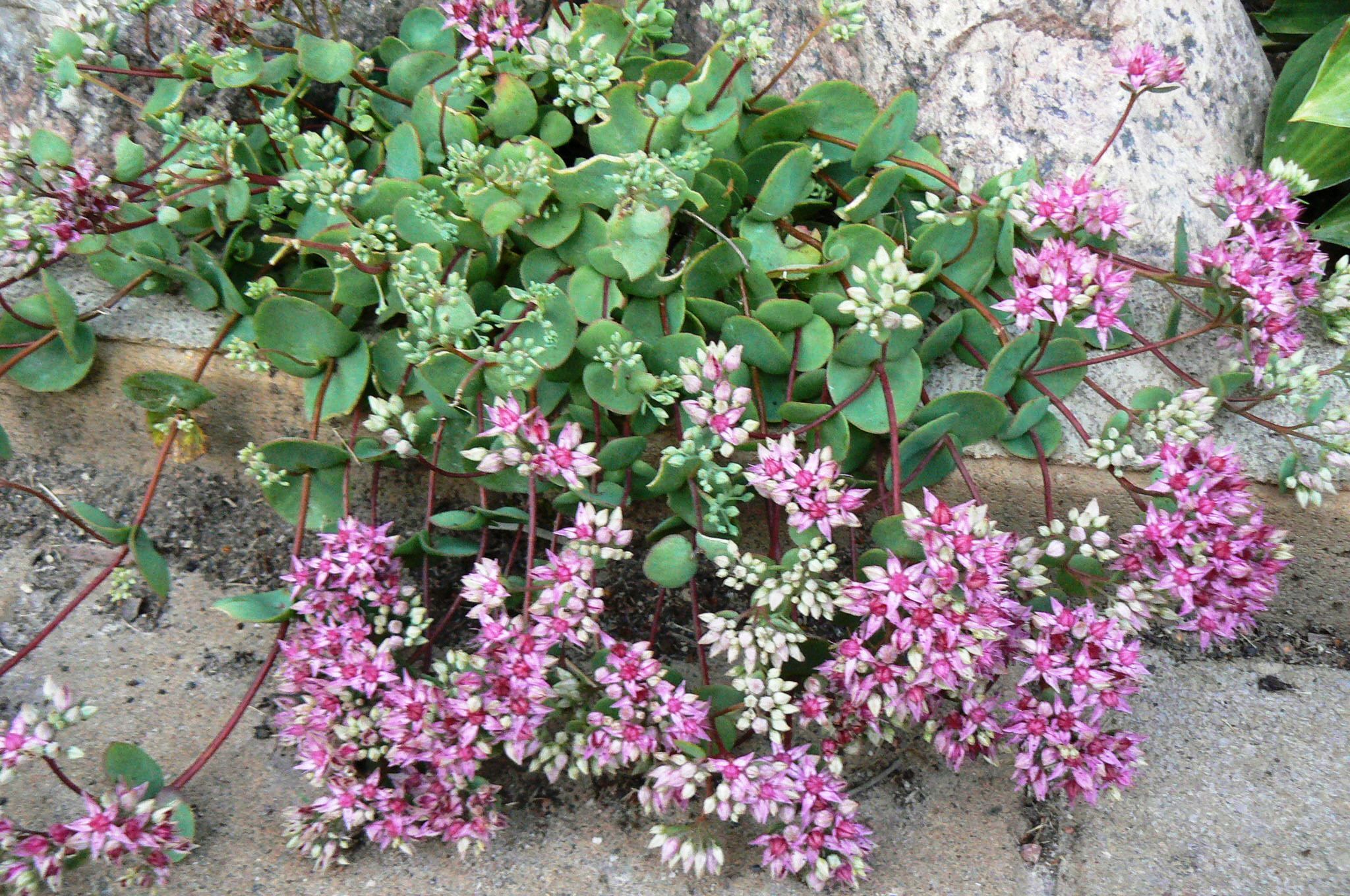
Shrub (tall) types and varieties of stonecrop with photo
In gardening, tall sedums are especially popular, because they are very unpretentious to the composition of the soil and do not require close attention. Unlike ground cover species, shrub plants need more frequent watering.
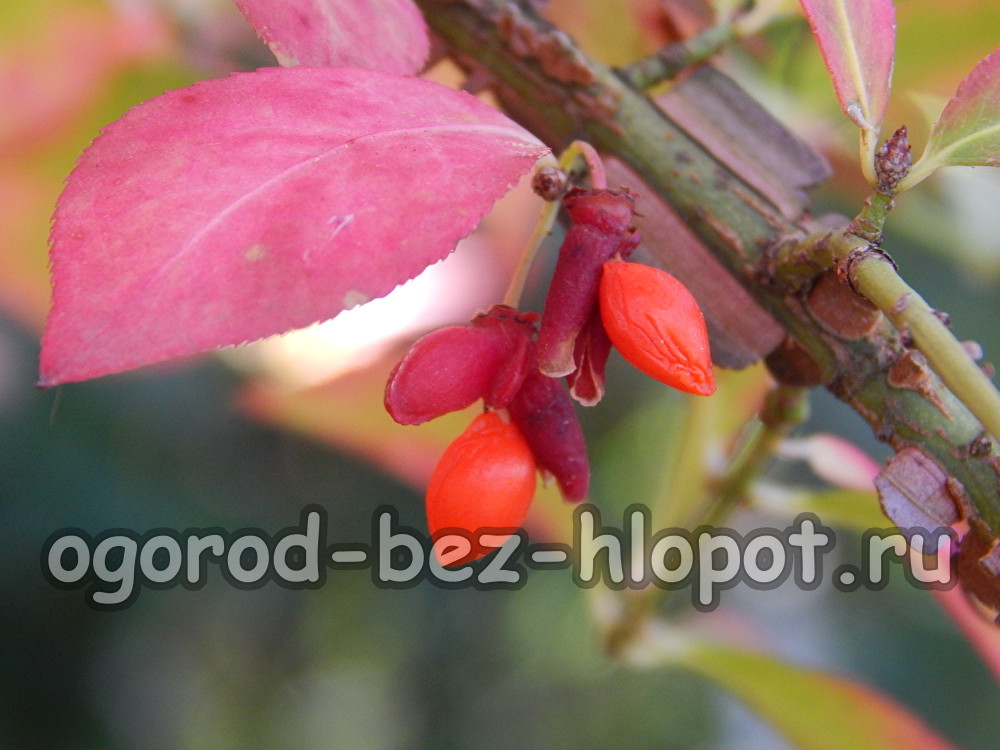 You may be interested in:
You may be interested in:Prominent (Sedum spectabile)
The height of the bush is within 30-70 cm. Green foliage is blue or gray in color. The color of inflorescences is raspberry, white, pink and purple. The flowering phase begins in late summer. Among flower growers, the varieties Iceberg, Carmen, Diamond, Neon are popular.
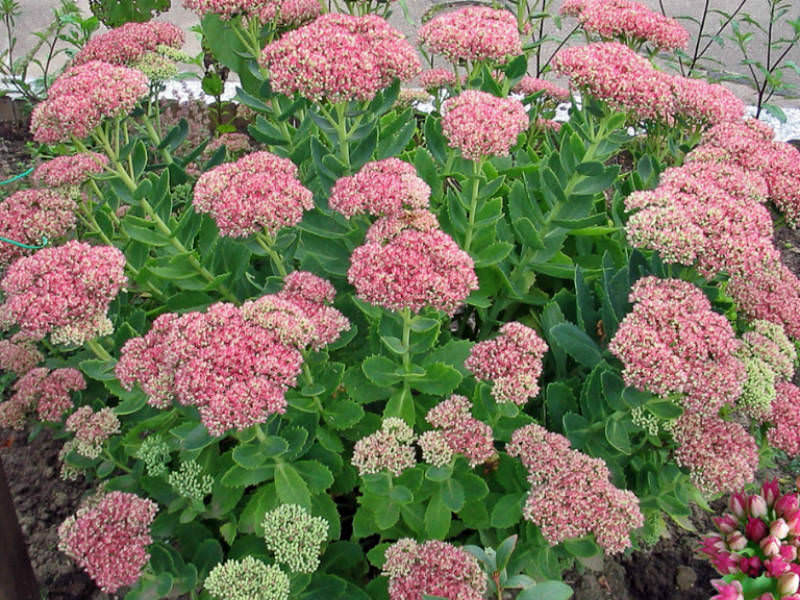
Tenacious (Sedum aizoon)
A tenacious stonecrop is distinguished by strong erect stems, which can grow no more than forty-five centimeters in height. Oblong-rhombic foliage at the edges finely serrated. Flowers have a yellow color. The most often grown stonecrop Aurantikum.
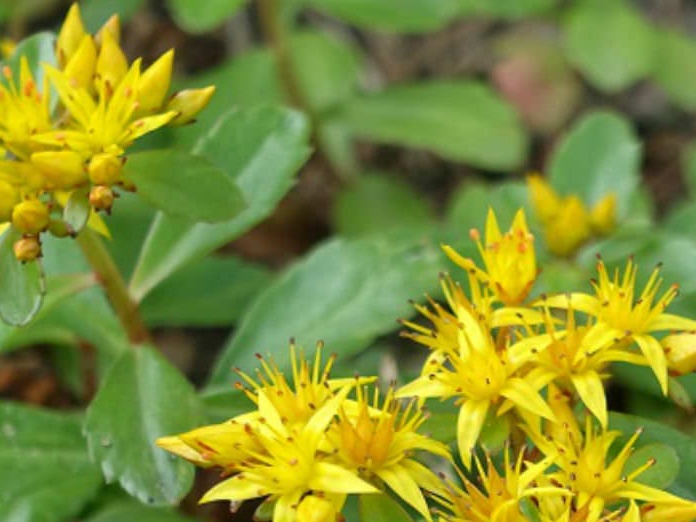
Reddish (Sedum eruthrostictum)
Among the variety of varieties, flower growers distinguish Frosty Morne and Mediaovariate. The bluish-green bushes reach 0.6 m. In September, pale pink or white flowers appear on the top of the bush, which sometimes have richly pink pistils.
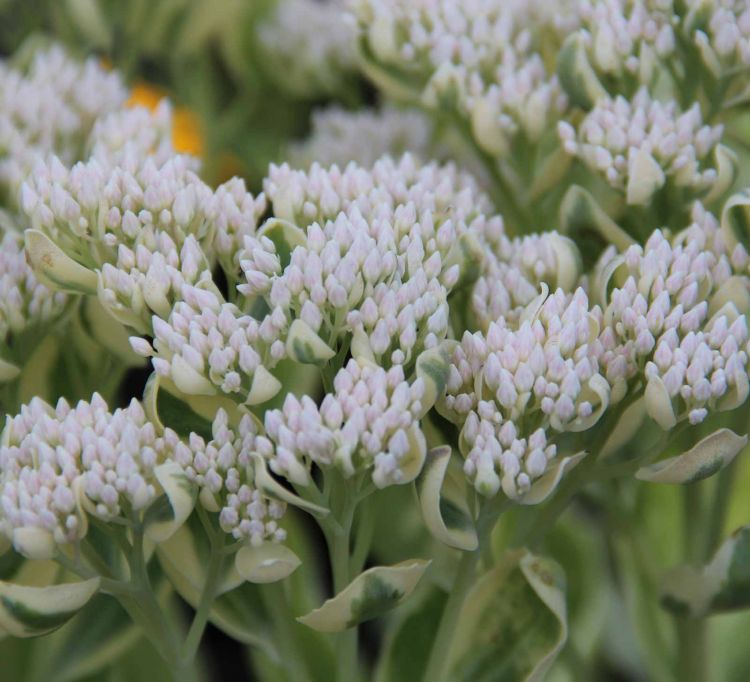
Middendorf (Sedum middendorfianum)
The plant forms a sprawling bush, the height of which is not more than 0.3 m. Numerous yellow flowers grow on densely leafy flower-bearing stems. Narrow foliage is painted in green tones.
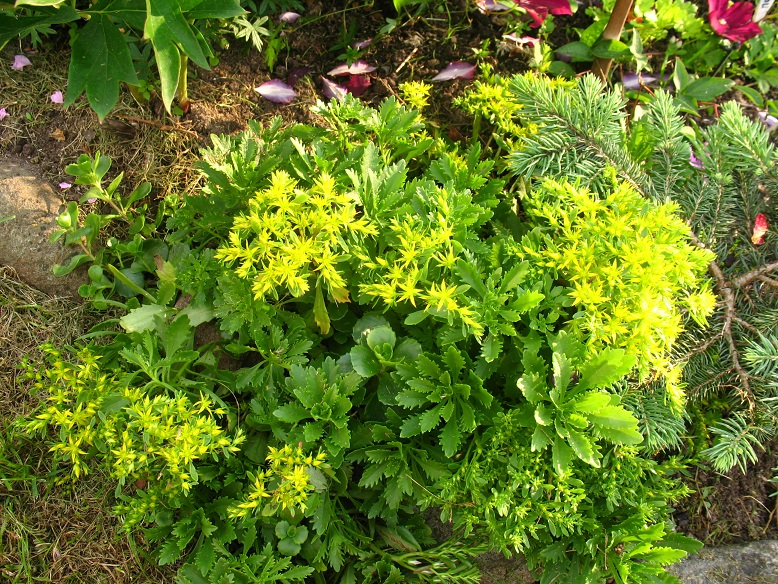
Common (Sedum telephium)
This species is characterized by a rather impressive bush height (0.8 m) and raspberry or pink inflorescences. Deciduous plates can be painted in green, raspberry, pink, bluish or brown tones. The plant blooms in mid-summer and blooms until the onset of autumn. Popular varieties are Red Globe, Bon-Bon and Jennifer.
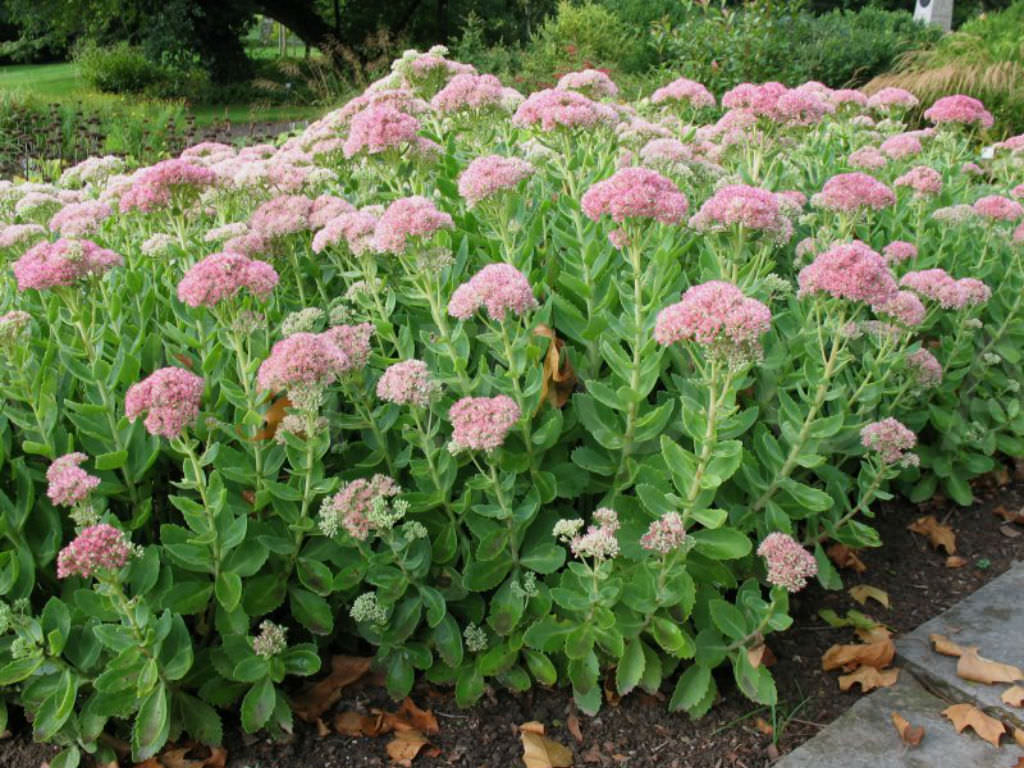
Plateau (Sedum pachyphyllum)
The thick-leaved sedum is a shrub whose stems grow to a length of 0.3 m.Cylindrical thick leaves have reddish tops, which gives the flower a special decorative effect. Inflorescences are formed from yellow or green-yellow flowers.
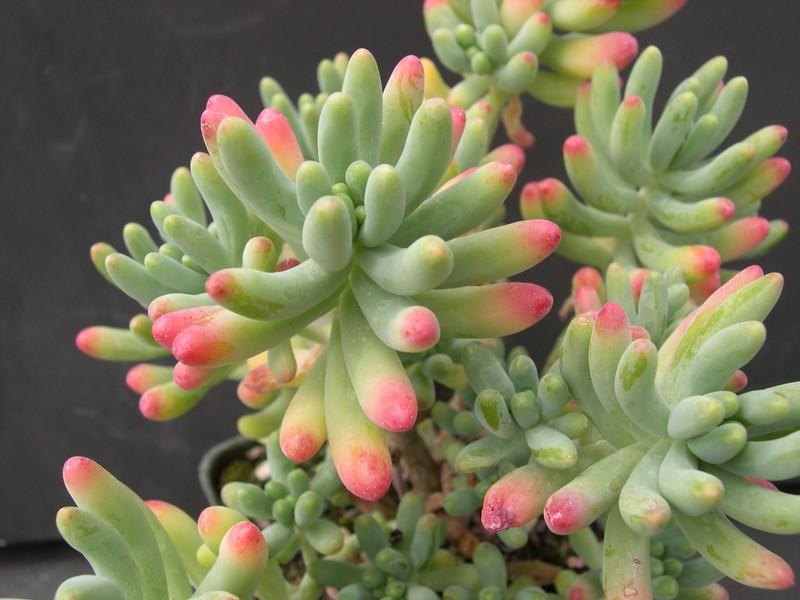
Home cleaning at home
Like most succulents, sedum is unpretentious to the conditions of detention. It is quite tenacious, therefore, it can grow even in such conditions in which no other plant would take root. Pinching helps give the bush a decorative look. The procedure allows you to restrain growth and contributes to the density of the crown. In varietal variegated plants, green stems are cut off so that the flower retains its varietal characteristics.
Lighting and temperature
Stonecrops are grown as decorative deciduous flowers, so a well-lit place is chosen for it. In the midday heat, bushes shade from direct rays.
During the period of active growth, the most comfortable air temperature is 24-27 ° C, in winter it is lowered to 8-10 ° C. Outdoor flowers need additional warming before frost.
Watering and feeding
Sedum does not require abundant watering, because it accumulates a lot of moisture in foliage and shoots. The need for water is determined by the complete drying of the upper layer of the substrate by several centimeters. In winter, watered only once a month, and with increased humidity in the room watering is completely excluded. It is not necessary to spray it, you can only periodically wipe the leaves from dust.
Fertilize the flower at the onset of spring and until mid-autumn. The frequency of feeding should not exceed 1-2 times every 30 days. For this purpose, you can use a complex of fertilizing for succulents.
Diseases, pests and methods of dealing with them
Stonecrop is quite resistant to disease, but if the conditions for care are violated, its immunity weakens. Excess moisture in the soil can cause stems to rot at the base, so watering should be moderate. When dropping the leafy part, you should lower the air temperature, because a too hot room harms the flower. Shriveled and yellow leaves indicate poor watering.
Pests are rarely interested in this plant. Mealyworms, aphids, and fungal microorganisms can settle on the aerial parts. You can get rid of insects with the help of insecticides, for example, Actellica or a soap solution.
Reproduction and transplantation
Stonecrop is propagated in three ways: by seeds, cuttings and dividing the bush. The first method is not used at home. Propagated by seeds only when breeding work with varieties.
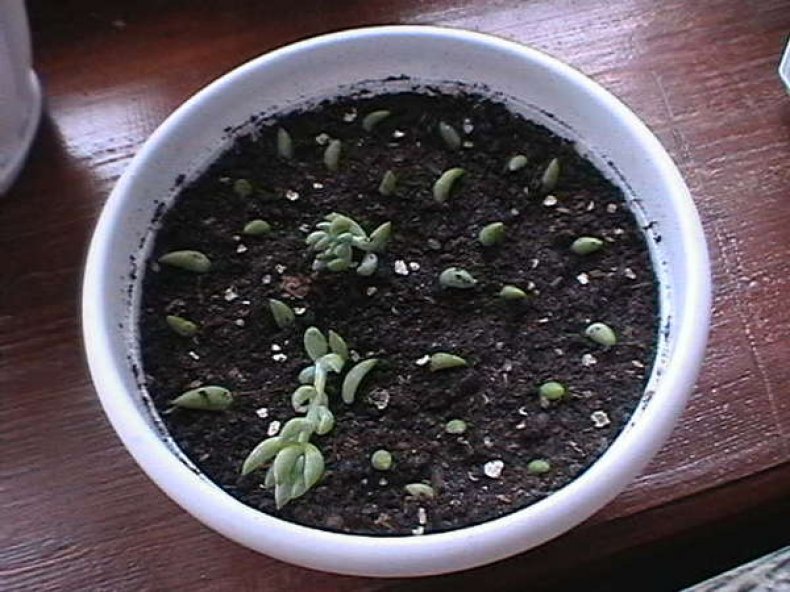
It is very simple to grow a sedum from a shank. From the maternal adult bush, it is necessary to cut off the apical stem and root it in a mixture of sand and peat. Florists practice rooting in containers of water. For dividing the bush, only adult and well-grown plants are suitable. The shoot is separated from the bush (always with the root) and transplanted into a separate container. Such sprouts take root well and can bloom in the year of planting.
- two parts of leaf and sod soil;
- one part of sand and peat;
- half of the charcoal.
Crushed stone, expanded clay or brick chips are used as drainage material.
Common questions
An unpretentious stonecrop grown on a site or in a house requires very little attention from the grower. Creeping species create beautiful living carpets, among which you can plant other plants with similar requirements for conditions.

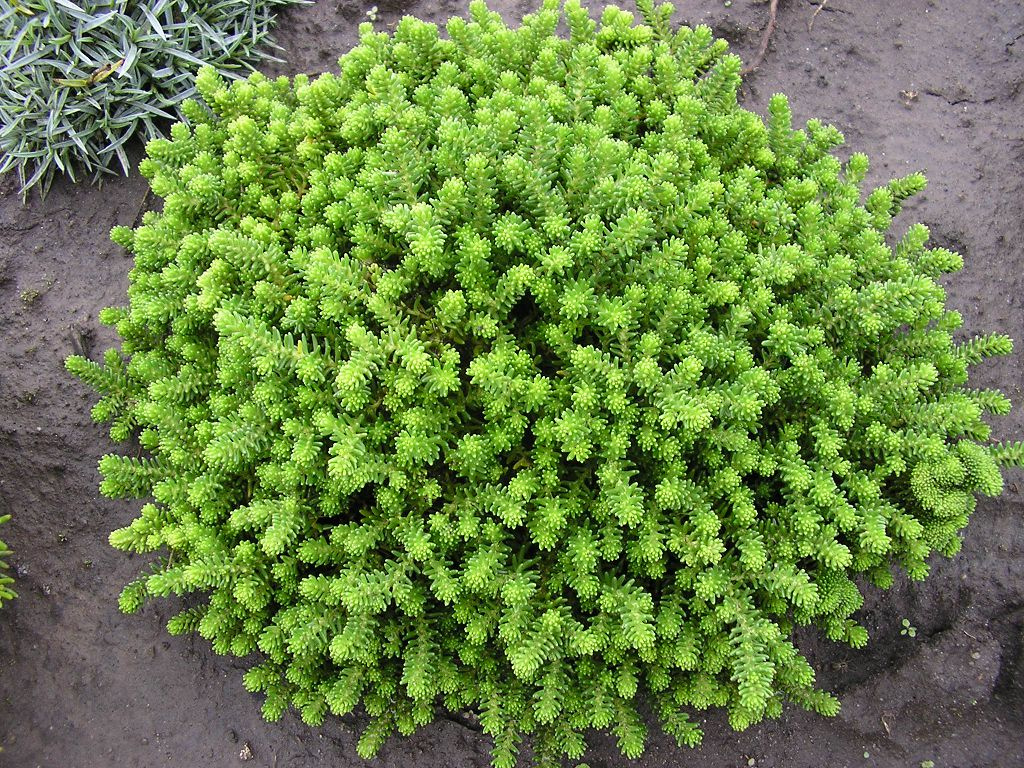
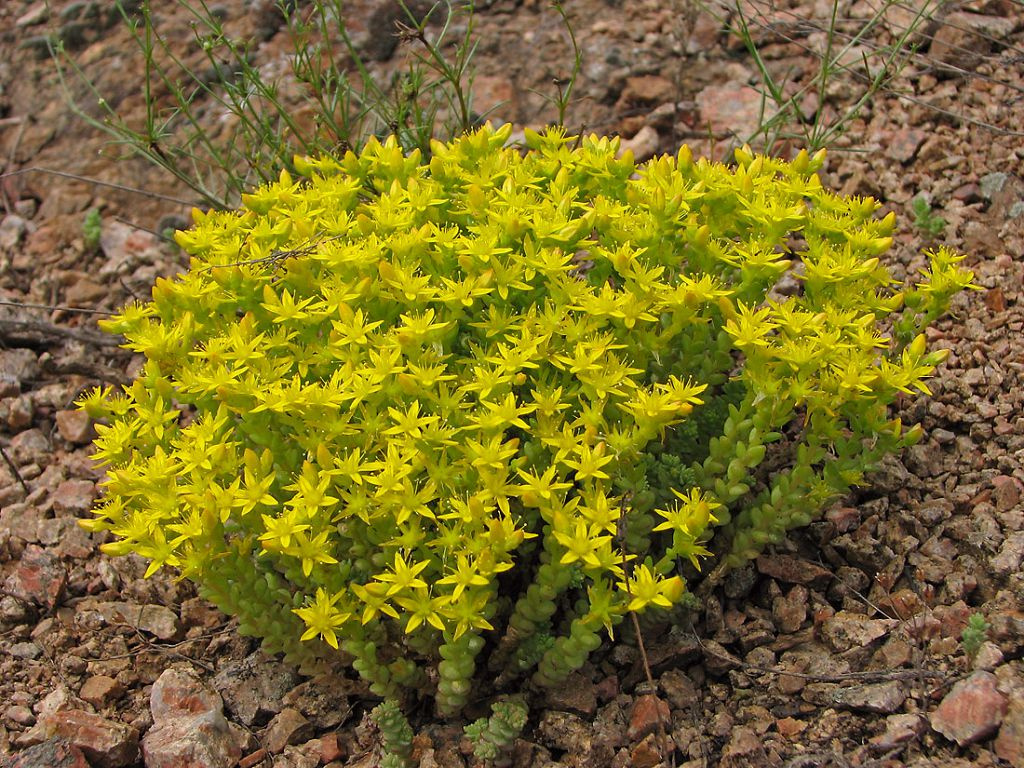
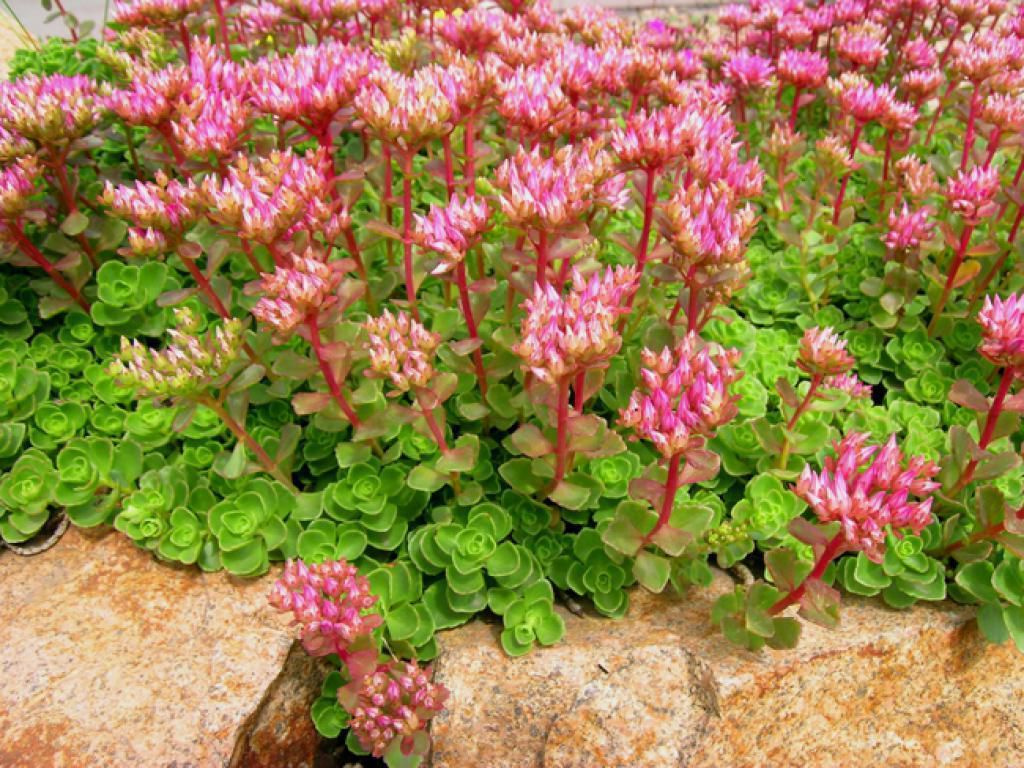



 10 beautiful annuals that bloom all summer
10 beautiful annuals that bloom all summer Sow in the ground, without seedlings: 10 beautiful and unpretentious flowers
Sow in the ground, without seedlings: 10 beautiful and unpretentious flowers Platicodon planting and outdoor care
Platicodon planting and outdoor care Hosta - planting and care in the open ground in the Urals
Hosta - planting and care in the open ground in the Urals